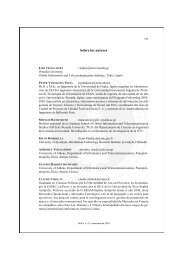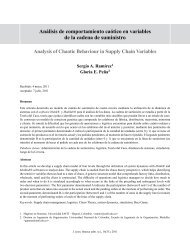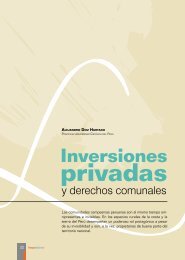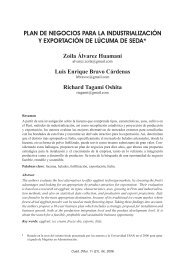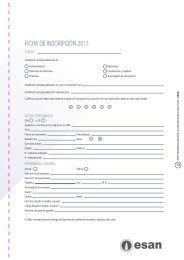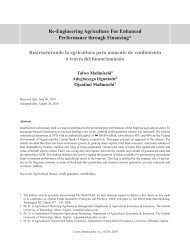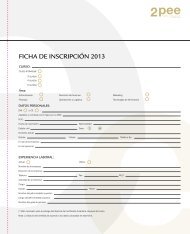42 Journal of Economics, Finance <strong>and</strong> Administrative ScienceDecember 2011Commerce’s Office of Travel <strong>and</strong> Tourism Industries(OTTI) for 1996-98. The countries of origin of the U.S.bound tourists were Brazil, Germany, Japan, Taiwan<strong>and</strong> the United Kingdom. The findings of these authorsindicate that the respondents from masculine culturesnegatively evaluated the airline ticket prices <strong>and</strong> overallservice quality. They also responded unfavorably to thequestion related to the loyalty to the airline for repeattravel. These findings were replicated in a subsequentstudy by Crotts <strong>and</strong> Litvin (2003), which used a subsetof the OTTI data for the year 2000. These two researchstudies explain the findings in terms of the traits ofachievement <strong>and</strong> aggression associated with masculinecultures. It is, therefore, interpreted that such traits mayresult in higher levels of expectations <strong>and</strong>/or stricterst<strong>and</strong>ards of evaluations.3. Accommodation: service quality evaluation:A study by Mattila (1999) examined the differencebetween Asian <strong>and</strong> Western tourists in their perceptionsof the service encounter <strong>and</strong> service quality evaluationfor two luxury hotels in Singapore. The researchersobserved the encounters between hotels’ front deskemployees <strong>and</strong> guests after which they asked the gueststo complete a questionnaire. The findings in this studyindicated that Asian tourists rated both the serviceencounter <strong>and</strong> service quality significantly lower thanWestern tourists. As discussed earlier, these results canbe attributed to the higher levels of expectations of Asiantourists due to the people oriented collectivistic natureof the Asian societies, as well as the inherent socialinequalities, which exist in these high power distancecultures leading to higher levels of expectations. Mattilaalso found that, while Asian tourists gave significantlylower ratings compared to western tourists, their facialexpressions did not reflect their inner feelings.Another study examining the tourists’ after-travelbehaviors related to the evaluation of hotel serviceswas conducted by Tsang <strong>and</strong> Ap (2007). These authorscompared the Asian <strong>and</strong> Western tourists’ evaluationsof the relational quality service provided by the guestcontact employees of a hotel in Hong Kong. The findingsof this study indicated that Asian tourists gave significantlylower ratings to the service quality comparedto Western tourists. The authors explain these findingsbased on differences on the cultural dimension of powerdistance between Asian <strong>and</strong> Western tourists. Further,the authors also found that different factors were takeninto consideration by Asian <strong>and</strong> Western tourists in theirevaluations. The relevant considerations for the Westerntourists included goal completion, efficiency <strong>and</strong> timesavings, whereas for Asian tourists the quality of interpersonalrelationship was the key consideration.ANALYSIS OF TOURIST BEHAVIORS: ACONCEPTUAL FRAMEWORK BASED ONHOFSTEDE’S CULTURAL DIMENSIONSThe literature review discussed in the previous sectionis summarized on Table 2. For each of the 17 studiesdiscussed in the literature review, the relevant touristbehavior(s) studied by the author(s) <strong>and</strong> Hofstede’s(1980, 2001), five cultural dimensions used to explainthe findings are identified on Table 2. Various touristbehaviors are identified with an index number indicatedon Table-1: BT1 to BT14 for Before-Travel stage, DT1to DT11 for During-Travel stage <strong>and</strong> AT1 to AT30 forAfter-Travel stage. The cultural dimensions used toexplain the findings are listed under the applicabletourist behavior domains. The following key is usedfor listing the five cultural dimensions: CD= ConfucianDynamism, IC= Individualism/Collectivism, MF=Masculinity/Femininity, PD= Power Distance <strong>and</strong> UA=Uncertainty Avoidance.An examination of the summary given on Table 2provides with some useful insights on the applicabilityof Hofstede’s cultural dimensions to various touristbehavior domains. There is a very clear pattern interms of which cultural dimensions are applicable onwhich stage of the tourist behavior. The behaviors inthe after-travel stage include only three of the originalfour dimensions <strong>and</strong> the uncertainty avoidance dimensionis missing in the studies of after-travel behaviors.Similarly, the power distance <strong>and</strong> masculinity/femininitydimensions are by <strong>and</strong> large missing for behaviors inthe before <strong>and</strong> during stages.J. econ. finance adm. sci., 16(31), 2011
Vol. 16, Nº 31Manrai & Manrai: Hofstede’s <strong>Cultural</strong> <strong>Dimensions</strong> <strong>and</strong> <strong>Tourist</strong> <strong>Behaviors</strong> 43The analysis summarized on Table 2 shows that onlyindividualism/collectivism <strong>and</strong> uncertainty avoidancedimensions are applicable in the before <strong>and</strong> duringstages. We also note that the fifth dimension (ConfucianDynamism) is by <strong>and</strong> large missing, except in Wong<strong>and</strong> Lau (2001) study, as a part of the overall index ofculture in Reisinger <strong>and</strong> Mavondo (2005) study, informulating some propositions in Meng (2010) study<strong>and</strong> in the development of some measures in Kim <strong>and</strong>McKercher (2011) study. This can be attributed to alarge extent to the fact that the Confucian Dynamismdimension has been discovered much later than the otherfour dimensions. We feel that the Confucian Dynamismdimension has a lot of potential for explaining severaltypes of tourist behaviors, <strong>and</strong> we discuss some ofthese issues in the next section. In the meanwhile, ourconceptual framework is based on the findings relatedto the original four dimensions of Hofstede (1980) asdiscussed in previous sections, <strong>and</strong> as summarized onTable 2.Our conceptual framework is based on the insightsdrawn from our analysis of the applicability of Hofstede’scultural dimensions to various domains of travelbehaviors <strong>and</strong> the processes underlying these applications.Based on these applicability patterns <strong>and</strong> ourunderst<strong>and</strong>ing of the underlying processes, we identifythree categories of behaviors. These are labeled “CollectivityOrientation Driven Travel <strong>Behaviors</strong>,” “RiskTendencies Driven Travel <strong>Behaviors</strong>,” <strong>and</strong> “SocialInteraction Driven Travel <strong>Behaviors</strong>.”For the “Social Interaction Driven Travel Behavior”category, the three relevant cultural value dimensionsare individualism/collectivism, power distance <strong>and</strong>masculinity/femininity. As previously discussed, thesethree dimensions together were earlier characterized byHofstede <strong>and</strong> Bond (1988) as expected social behaviorscapturing the behavior of individuals in different socialsituations: behavior towards groups, behavior towardsjuniors <strong>and</strong> seniors <strong>and</strong> behavior as a function of anindividual’s social gender roles respectively. It is indeedstriking to note that tourist behaviors, which involveevaluations of their social encounters <strong>and</strong> experiencessuch as behaviors mostly in the after-travel category,st<strong>and</strong> out in terms of the application of these threecultural dimensions. The findings of the present studysuggest that these three dimensions may exercise theirinfluence either independently, in pairs or all three atthe same time.As regards the other two categories of behaviors,“Collectivity Orientation Driven Travel Behavior” <strong>and</strong>“Risk Tendencies Driven Travel <strong>Behaviors</strong>,” anotherclear pattern was noted based on the results summarizedon Table 2. For both before-travel <strong>and</strong> during-travelstages, the two dominant dimensions were individualism/collectivism<strong>and</strong> uncertainty avoidance. Further,for both stages of travel behaviors, these two dimensionsacted independently as well as in conjunctionwith each other.An in depth analysis of research done in this area,however, suggests that the underlying processes, throughwhich the cultural influences work, are very differentfor before <strong>and</strong> during stages of travel behaviors. Manyof the research studies discussed that tourists resort tomeasures such as group travel, traveling with a largeparty, etc., in order to reduce risk associated with travelingalone in a foreign country. Thus, risk reductionis the objective or motive that leads to a collectivisticaction or outcome on part of many tourists in theduring-travel stage. On the other h<strong>and</strong>, past researchfindings also indicate that many societies of the East,such as Japan <strong>and</strong> China, prefer to travel in groups dueto the collectivistic nature of those societies. Thus, inthese cultures collectivism is not an action or outcomeof the risk reduction tendencies; it is an objective ormotive in itself. The individuals in such collectivisticsocieties do receive the benefit of reduced risk associatedwith group travel; however, that is not the mainor only reason why they travel in groups in the firstplace. Instead, collectivism is a preferred way of lifeto most Asian societies, an example being the conceptof Japanese Travel Life Cycle discussed earlier. Thisdistinction between the before <strong>and</strong> during stages oftravel can be summed up as a sequential motive <strong>and</strong>outcome relationship. For the during-travel stage, riskreduction is the motive, which results in a collectivisticoutcome (UA IC) whereas in the before-travel stage,J. econ. finance adm. sci., 16(31), 2011
- Page 1 and 2: Hofstede’s Cultural Dimensions an
- Page 3 and 4: Vol. 16, Nº 31Manrai & Manrai: Hof
- Page 5 and 6: Vol. 16, Nº 31Manrai & Manrai: Hof
- Page 7 and 8: Vol. 16, Nº 31Manrai & Manrai: Hof
- Page 9 and 10: Vol. 16, Nº 31Manrai & Manrai: Hof
- Page 11 and 12: Vol. 16, Nº 31Manrai & Manrai: Hof
- Page 13 and 14: Vol. 16, Nº 31Manrai & Manrai: Hof
- Page 15 and 16: Vol. 16, Nº 31Manrai & Manrai: Hof
- Page 17 and 18: Vol. 16, Nº 31Manrai & Manrai: Hof
- Page 19: Vol. 16, Nº 31Manrai & Manrai: Hof
- Page 23 and 24: Vol. 16, Nº 31Manrai & Manrai: Hof
- Page 25 and 26: Vol. 16, Nº 31Manrai & Manrai: Hof



